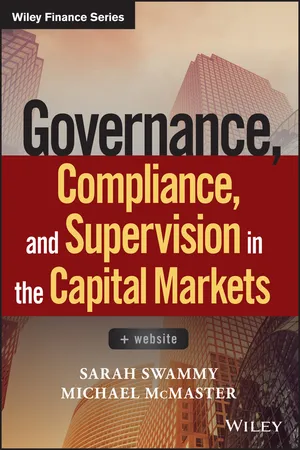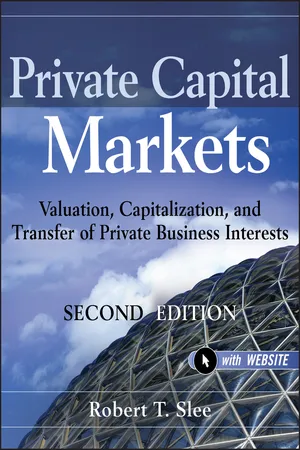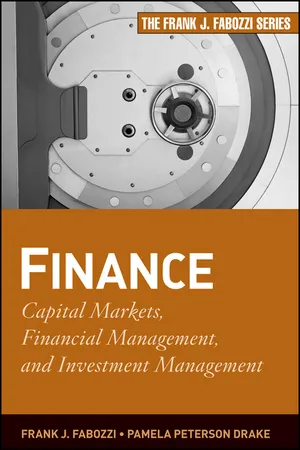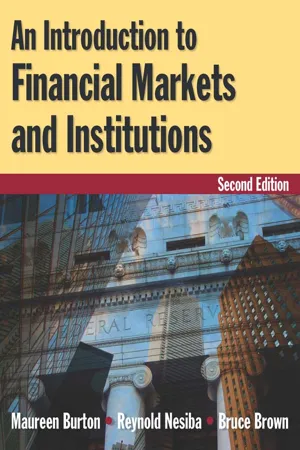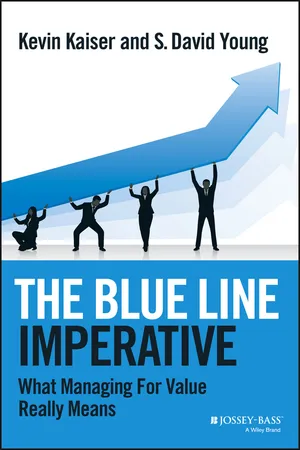Economics
Capital Market
The capital market is a financial market where long-term debt or equity-backed securities are bought and sold. It provides a platform for businesses and governments to raise funds by issuing stocks and bonds, and for investors to buy and sell these securities. The capital market plays a crucial role in allocating financial resources and facilitating economic growth.
Written by Perlego with AI-assistance
Related key terms
8 Key excerpts on "Capital Market"
- eBook - ePub
An Introduction to International Capital Markets
Products, Strategies, Participants
- Andrew M. Chisholm(Author)
- 2009(Publication Date)
- Wiley(Publisher)
1 Introduction: The Market Context1.1 CAPITAL AND THE Capital MarketS
Financial capital can be defined as accumulated wealth that is available to create further wealth. The Capital Markets are places where those who require additional funds seek out others who wish to invest their excess. They are also places where participants can manage and spread their risks. Originally, Capital Markets were physical spaces such as coffee houses and then purpose-built exchanges. In our day, Capital Markets participants may be located in different continents and conduct deals using advanced information technology.Who are the users of capital? In a broad sense we all are, at least part of the time. We borrow money to buy a house or a car so that we can live our lives, do our jobs, and make our own small contribution to the growing wealth of nations. We save to pay school and university tuition fees, investing in the ‘human capital’ that will sustain the economic health of the country. More narrowly, though, financial capital is used by corporations, governments, state and municipal authorities, and international agencies to make investments in productive resources. When a company builds a new factory it is engaged in capital expenditure - using funds provided by shareholders or lenders or set aside from past profits to purchase assets used to generate future revenues. Governments use tax revenues to invest in infrastructure projects such as roads. Agencies such as the World Bank inject funds into developing countries to create a basis for economic growth and future prosperity.Who are the suppliers of capital? Again, the answer is that we all are. Sometimes we do this directly by buying shares issued by corporations and debt securities issued by governments and their agencies. Sometimes we employ brokers to invest funds on our behalf. We deposit cash in bank accounts, invest in mutual funds, and set aside money in pension plans for our retirement. We pay taxes to the government and local authorities. We pay premiums to insurance companies who invest the proceeds against their future liabilities. Companies too become sources of capital when they reinvest their profits rather than paying cash dividends to shareholders. - eBook - ePub
Corporate Finance
Theory and Practice
- Pierre Vernimmen, Pascal Quiry, Yann Le Fur(Authors)
- 2022(Publication Date)
- Wiley(Publisher)
market-based economy, companies cover most of their financing needs by issuing financial securities (shares, bonds, commercial paper, etc.) directly to investors. A Capital Market economy is characterised by direct solicitation of investors' funds. Economic agents with surplus resources invest a large portion of their funds directly in the Capital Markets by buying companies' shares, bonds, commercial paper or other short-term negotiable debt. They do this either directly or through mutual funds. Intermediation gives way to the brokerage function, and the business model of financial institutions evolves towards the placement of companies' securities directly with investors.In this economic model, bank loans are extended primarily to households in the form of consumer credit, mortgage loans, etc., as well as to small enterprises that do not have access to the Capital Markets.The following graphs provide the best illustration of the rising importance of Capital Markets.…be it in terms of the number of listed companies…Note: Domestic companies only.Source: Data from World Federation of Exchanges, NYSE-Euronext, London Stock Exchange, Bourse de Casablanca, Bolsa Madrid, Beirut Stock Exchange, Borsa Italiana…or market capitalisationSource: Data from World Federation of Exchanges, NYSE-Euronext, Beirut Stock exchange, Borsa Italiana, London Stock ExchangeTransaction volumes are linked to the economic environment, even if the long-term trend shows a clear increase.Source: Data from World Federation of Exchanges, SIFMASection 15.2 PRIMARY, SECONDARY AND DERIVATIVE MARKETS
1/ FROM THE PRIMARY MARKET TO THE SECONDARY MARKET
The new issues market (i.e. creation of securities) is called the primary market. Subsequent transactions involving these securities take place on the secondary market. Both markets, like any market, are defined by two basic elements: the product (the security) and the price (its value).Thus, shares issued or created when a company is founded can later be floated on a stock exchange, just as long-term bonds may be used by speculators for short-term strategies. The life of a financial security is intimately connected with the fact that it can be bought or sold at any moment. - eBook - ePub
Quantitative Financial Analytics
The Path to Investment Profits
- Edward E Williams, John A Dobelman;;;(Authors)
- 2017(Publication Date)
- WSPC(Publisher)
Chapter 3 The Securities Markets and Macroeconomics This [financial] crisis. . . has turned out to be much broader than anything I could have imagined. . . Alan Greenspan, October 23, 2008 The Securities Markets Negotiable financial assets are traded in the money and Capital Markets. The distinction between the two is based upon the maturity of the financial asset under consideration. The money market is generally defined as consisting of negotiable securities with a maturity of one year or less; the Capital Market is composed of the longer-term securities (including equities, which have a theoretically perpetual life). The distinction, however, is generally more significant than the mere artificial division at the one-year maturity level. The instruments of the money market, aside from being less than a year in maturity, are also generally of high investment quality and are purchased as a means of obtaining some return on temporarily idle funds; in other words, the money market is a market in near-money instruments where safety of principal and liquidity are the primary considerations. The Capital Market, on the other hand, not only includes securities of all degrees of risk but also tends to be utilized by investors with funds to be committed for substantial periods. Finally, long-term debt securities constitute a portion of the Capital Market at the time of their issuance, but as they approach maturity they become money-market instruments. We shall begin the discussion with the more traditional money-market instruments, which, in the context of this book, may be viewed as possible interest-earning cash substitutes in the investment portfolio. Securities of the U.S. government The U.S. treasury bill is one of the most significant money market instruments. This short-term U.S. government obligation is offered in 28-, 91-, and 182-day maturities. Bills do not carry an interest coupon but are sold at less than their face value - Sarah Swammy, Michael McMaster(Authors)
- 2018(Publication Date)
- Wiley(Publisher)
CHAPTER 1 Capital Markets Participants, Products, and FunctionsThis chapter provides an introduction to the participants, products, and functions of capital. We also discuss the important role Capital Markets play in supporting economic growth and development (Figure 1.1 ). We start with a detailed discussion of key participants and how Capital Markets support their economic activities. We then introduce the foundational product groups offered and review their key features and uses. Then we will explain the various types of markets and how they facilitate the funding and investing needs of participants.Capital Markets environment.FIGURE 1.1THE BASIC PRODUCTS OFFERED IN Capital MarketS
For the focus of our discussion we view Capital Markets as offering two types of funding products to issuers: Equities and debt (also called fixed income) through both primary (initial issuance of securities) and secondary (ongoing trading of securities) markets. From a broader perspective, Capital Markets may also include the trading commodities, currencies, and derivatives.Equities
Equities, also known as shares and stocks, represent an ownership interest in a corporation; the term share means each security is a share of ownership in a corporation. Shares have the same limited‐liability rights of the corporations they represent, which means that the liability of share owners is limited to their investment amount. Shares are initially created when a corporation is formed, whereby the owners can choose the number of shares appropriate for the corporation's plans and valuation. At this point the corporation is known as a private corporation, as all the shares are held by a close group of investors.As corporations grow, some may choose to become a public corporation, or one that is listed on a public stock exchange, where members of the public can openly buy or sell shares. This process is known as listing where existing or additional shares may be created and offered to the public through an initial public offering (IPO).- eBook - ePub
Private Capital Markets
Valuation, Capitalization, and Transfer of Private Business Interests
- Robert T. Slee(Author)
- 2011(Publication Date)
- Wiley(Publisher)
CHAPTER 1 Capital MarketsThis book explores private Capital Markets, the last major uncharted financial markets. Private markets contain millions of companies, which generate more than half of the gross domestic product (GDP) of the United States and the world. Yet these markets are largely ignored, partly because of the difficulty obtaining information and partly because of the lack of a unified structure to approach them. This work offers such an approach. It provides a theoretical and practical framework that enables readers to make sound investment and financing decisions in the private Capital Markets.A Capital Market is one in which businesses can raise debt and equity funds. Since the 1970s, public Capital Markets have received almost all of the attention from academics in the literature.1 In 2004, the first edition of this book challenged the assumption that public and private Capital Markets are substitutes, showing instead that the two markets were different in most meaningful ways. Specifically, 12 factors differentiate public and private markets:2 - eBook - ePub
Finance
Capital Markets, Financial Management, and Investment Management
- Frank J. Fabozzi, Pamela Peterson Drake(Authors)
- 2009(Publication Date)
- Wiley(Publisher)
money market funds and have restrictions as to what they can invest under U.S. securities law. Preferred stock would qualify if certain conditions are satisfied.Capital Market
The Capital Market is the sector of the financial market where long-term financial instruments issued by corporations and governments trade. Here “long-term” refers to a financial instrument with an original maturity greater than one year and perpetual securities (those with no maturity). There are two types of Capital Market securities: those that represent shares of ownership interest, also called equity, issued by corporations, and those that represent indebtedness, issued by corporations and by the U.S., state, and local governments.Earlier we described the distinction between equity and debt instruments. Equity includes common stock and preferred stock. Because common stock represents ownership of the corporation, and because the corporation has a perpetual life, common stock is a perpetual security; it has no maturity. In later chapters we describe common stock in more depth. Preferred stock also represents ownership interest in a corporation and can either have a redemption date or be perpetual.A Capital Market debt obligation is a financial instrument whereby the borrower promises to repay the maturity value one year after issuance. These debt obligations can be broken into two categories: bank loans and debt securities. While at one time, bank loans were not considered Capital Market instruments, in recent years a market for the buying and selling of these debt obligations has developed. One form of bank loan that is bought and sold in the market is a syndicated bank loan. This is a loan in which a group (or syndicate) of banks provides funds to the borrower. The need for a group of banks arises because the amount sought by a borrower may be too large for any one bank to be exposed to the credit risk of that borrower.Debt securities include (1) bonds, (2) notes, (3) medium-term notes, and (4) asset-backed securities. The distinction between a bond and a note has to do with the number of years until the obligation matures when the security is originally issued. Historically, a note is a debt security with a maturity at issuance of 10 years or less; a bond is a debt security with a maturity greater than10 years.8 - Maureen Burton, Reynold F. Nesiba, Bruce Brown(Authors)
- 2015(Publication Date)
- Routledge(Publisher)
Part 4 Financial Markets- The Money Markets
- The Corporate and Government Bond Markets
- The Stock Market
- The Mortgage Market
Passage contains an image
Chapter Eleven 11 The Money Markets
DOI: 10.4324/9781315706405-15The need for a money market arises because receipts of economic units do not coincide with their expenditures. —Timothy Q. Cook and Robert K. LaRocheLearning Objectives
After reading this chapter, you should know:- What the money market is and how it is used by various participants
- Recent trends in money market instruments
- How the money markets have become international in scope
- What money market mutual funds are and why they have become important intermediaries
Financial Markets
In Part 4 of this text, we examine debt and equity markets more closely. The next three chapters look at the various Capital Markets, where financial assets with a maturity of greater than one year (or no maturity at all) are traded. Capital Markets include the bond, stock, and mortgage markets and we spend a chapter discussing each one. In this chapter, we look at the money market—the short-term credit market where debt securities having original maturities of one year or less are traded. This definition distinguishes the money market from the Capital Market for longer-term debt and equity transactions. We begin by exploring how various participants use money market instruments to meet their borrowing and lending needs. In the second section, we review the individual money market instruments (originally covered in Chapter 3 ) and the development of money market mutual funds (MMMFs).- eBook - ePub
The Blue Line Imperative
What Managing for Value Really Means
- Kevin Kaiser, S. David Young(Authors)
- 2013(Publication Date)
- Jossey-Bass(Publisher)
Another major hindrance was debtor's prisons. Made infamous in the work of Charles Dickens, debtor's prisons hardly made it easier for people to pay back their debts, not least because it's hard to earn a paycheck while you're in jail. The cramped conditions in such places also generated the constant threat of death from transmissible diseases. Imprisonment for debt was abolished in the United States in 1833, and most European countries followed suit shortly thereafter. Another obstruction to high-functioning Capital Markets was removed, leading to another upturn in growth.As the normal inborn snags were detected and dealt with, the Capital Market boomed, emerging from its early growing pains to become truly global. Today, there are nearly 250 stock exchanges all over the world, from the mighty New York Stock Exchange, with some 2,800 listings and a market capitalization of nearly $12 trillion,8 to the 19 stocks9 traded on the Port Moresby Stock Exchange in Papua New Guinea. One of the newest to join the bandwagon is the Rwanda Stock Exchange, which opened in Kigali in January 2008, trading exclusively in government bonds at first and expanding, in 2009, to equity listings. The World Federation of Exchanges reported that by year-end 2012, total market capitalization for the 52 regulated exchanges it represents was approximately $55 trillion, with more than 46,000 listed companies.10 We seem to know when to take a good idea and run with it.How Capital Markets Help Us Get Our Stuff
In pre-modern times, not unlike today, there were entrepreneurs – the people with the ideas but without the money – and there were investors – the people with the money but without the ideas. We've discussed the acute problem the entrepreneurs faced: getting money in their hands to develop their ideas to make the world a better place, at least potentially. But before you direct all your sympathy to the entrepreneurs, consider the investors' position as well. Sure, it would have been nice for the people with the money to indiscriminately fund every idea that came along, thereby ensuring that the right ones would eventually rise to the top.But there was a reason they didn't. There was a reason that they only tended to invest in the ideas of family members or others in their immediate circle who they felt they could trust. In today's world, what is the constant message we're given? It is to diversify our risk to every extent possible. For early shareholders and investors, with their limited supply of relatives, friends, or high-ranking connections, investment risk was virtually the opposite of diversified. If they did take the investment plunge, they could do it in only so many ways, after which they could do nothing but hope for the best. Returns were typically all or nothing – you paid for the ship, and then sat back to wait for it to come in with the spices and jewels the merchant had promised. As often as not, the ship sank (perhaps because it didn't have one of John Harrison's Longitude Prize-winning clocks on board), and the investor lost the lot, unless he'd taken on the additional cost of insurance, which was just as expensive and unpopular as it is today. In the case of Antonio in Shakespeare's The Merchant of Venice
Learn about this page
Index pages curate the most relevant extracts from our library of academic textbooks. They’ve been created using an in-house natural language model (NLM), each adding context and meaning to key research topics.



